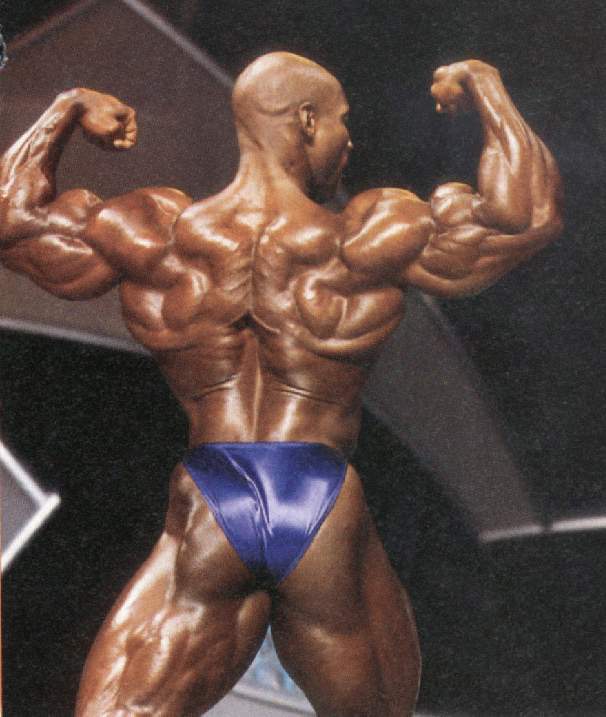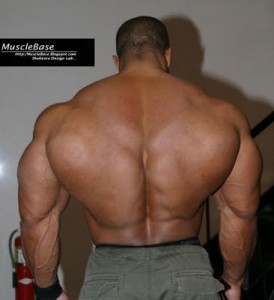The 20 best backs of all time: FLEX ranks the bodybuilders who displayed the greatest rear views in the history of the sport and shares their best advice on how those legendary proportions were built
It’s more than just the pairing of immense mass with intricate details that makes the best backs such crowd favorites. It’s their unpredictability. As opposed to pecs and delts, the contours of which seldom vary greatly from one bodybuilder to the next, when someone unfurls a lat spread or locks in a rear double biceps, the potential permutations are vast, as a melange of muscles big (lats, traps, spinal erectors) and small (teres major and minor, infraspinatus, rhomboids) jockey for attention.
Criteria
Our 20 selections for the greatest backs of all time embody this variety, coming in all shapes, but mostly the largest sizes. Some are wider, thicker or more deeply divided, some are freakier, others more elegant. With their every movement, though, each of them, from number 20 to number one, awed audiences in their own unique ways.
20 Albert Beckles
This ageless winner of eight pro shows had the narrowest lats on our list, and yet he may have possessed the most detailed back of all time. It looked like scores of golf balls squirming beneath his taut skin as he tensed up for a back double biceps or his signature rear archer pose.
Cleaning Up
“If I have a secret weapon, it’s the power clean. I almost always include cleans in my back routine, doing them for four to six sets of 10-15 reps. They really bring out my spinal erectors and my trapezius from top to bottom.”
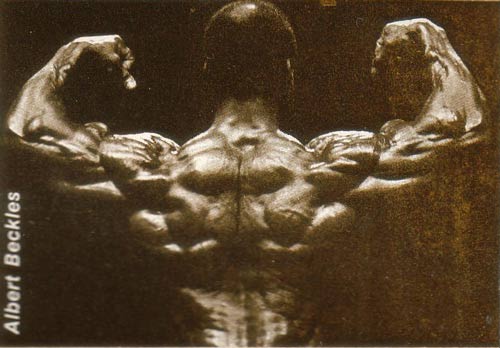 19 Melvin Anthony
19 Melvin Anthony
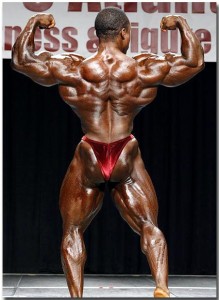 The Marvelous One presents probably the most aesthetically pleasing rear double-biceps pose in bodybuilding today, with “feathered” wings flaring dramatically from his 27″ waist, and set off by ranges of ridges and ravines.
The Marvelous One presents probably the most aesthetically pleasing rear double-biceps pose in bodybuilding today, with “feathered” wings flaring dramatically from his 27″ waist, and set off by ranges of ridges and ravines.
Stretch and Contract
“The key to a great back is getting a good stretch and a full contraction for every rep. You need to feel the lats being fully stretched out at the start of each rep of an exercise like pulldowns or dumbbell rows, and then you need to feel the muscles of the middle back tensed as much as you can at the contraction. Forget the weight and try to maximize this feeling of stretching and contracting your back rep after rep.”
18 Thierry Pastel
As with Anthony, the visual impact of Pastel’s splaying lats was heightened by his wispy waistline. This was most evident in shots like the front double biceps, and in his front lat spread, in which the breadth of his back highlighted the Frenchman’s flowing curves.
Pulldown Menu
“I often alternate my reps when doing pulldowns. I do one rep pulling the bar down in front of my head and the next rep pulling it down behind my neck, going back and forth for 12-20 reps. I also like to both start and finish my back workouts with pulldowns to get blood in my upper back at the beginning and maximize the pump at the end.”
17 Tony Pearson
If ever a man could fly unassisted, it would’ve been the 1978 Mr. America at his peak, partly because Pearson is one of the lightest men on our list (his legs were slim in relation to his upper body) but also because of his hang-glider lats.
16 Sergio Oliva
The three-time Mr. Olympia (1967-69) revered as The Myth was decades ahead of his time. Nowhere was this more evident than in the vast slab of flesh on the backside of his torso. He used his bulging lats in the front double-biceps and his signature arms-up victory poses to eclipse his competition.
Supersets, Super Back
“I like to include supersets in my back routine, doing one exercise for width and one rowing exercise, so I superset Nautilus pullovers with T-bar rows or chins with barbell rows. Sometimes, instead, I superset every back exercise with a chest exercise, working both areas together.”
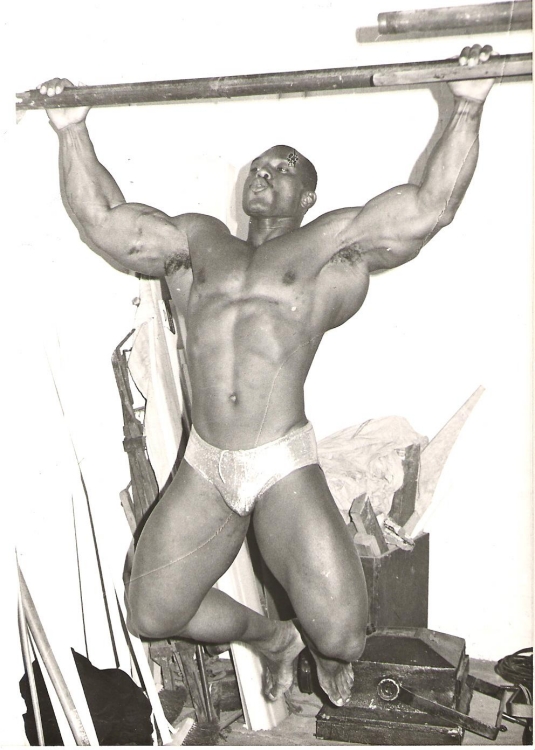
15 Orville Burke
The winner of the 2001 Night Of Champions sported high lat attachments, but this only added to the cartoonish quality of one of the broadest silhouettes ever. (The same claim can be made of Dennis Wolf.) Burke attributed much of his width to chinning regularly when growing up in Jamaica before he’d even begun weight training.
14 Art Atwood
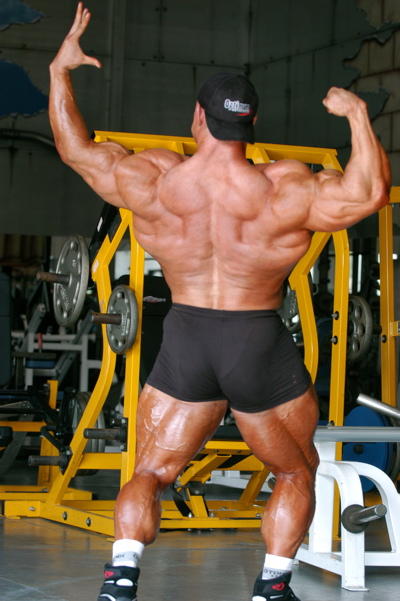 It’s unlikely Modern Art will ever showcase the assortment of lines most others in our top 20 possess. Still, for sheer bulk packaging, few can surpass the sail-like breadth of his low-draped lats.
It’s unlikely Modern Art will ever showcase the assortment of lines most others in our top 20 possess. Still, for sheer bulk packaging, few can surpass the sail-like breadth of his low-draped lats.
Topping It Off
“I always include top deadlifts in my back routine, and I usually do them after one type of row and before another type of row, because I don’t think of them as a lower-back exercise. Set the bar supports in a power rack just above knee level, and begin each rep from this position. Don’t try to explode the bar up, but, instead, do steady controlled reps for sets of 10. Focus on the lats by squeezing them, although you will feel these in your spinal erectors and traps, too.”
13 Flex Wheeler
In the 17 pro contests Wheeler won, he was probably never the widest man onstage. Still, in prime condition, his back possessed a wealth of unique qualities, from mid-traps vascularity to “half-softball” infraspinatus to prominent “horizontal blinds” striations in his lower lats.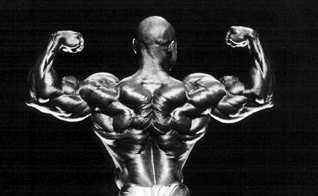
12 Robby Robinson
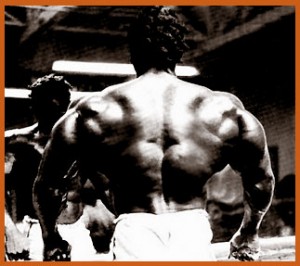 As with Oliva’s size a decade prior, Robinson’s finely detailed physique of the late ’70s was so far ahead of its time, it still looks modern today. At no time was this truer than when he crunched out a rear double biceps and bold ridges emerged like snakes.
As with Oliva’s size a decade prior, Robinson’s finely detailed physique of the late ’70s was so far ahead of its time, it still looks modern today. At no time was this truer than when he crunched out a rear double biceps and bold ridges emerged like snakes.
11 Mohamed Benaziza
The 5’3″ Algerian was one of only two men to defeat Dorian Yates in the pros (the other is number four on our list), and Momo did so at the 1990 Night Of Champions with back separation that ushered in a new era of glutes-to-delts details.
The High Way
“I prefer to keep my reps for back exercises in the 15-20 range. I don’t really feel that I’ve begun to make the mental connection with the muscles I’m training until I get to about the 12th rep. As far as training heavy goes, I’ve had problems lifting heavier weights for lower reps, tending to accumulate nagging injuries and joint pains. I also don’t seem to grow as well unless I keep my reps up.”
10 Victor Martinez
The Dominican Dominator possesses the winning combination of width and thickness in his latissimus dorsi, and his prominent V is set off by narrow hips and wide clavicles. After years of heavy basics, both of his rear shots are Sandow-worthy.
9 Michael Francois
The 1993 NPC Nationals winner took the professional ranks by storm, winning the first four pro contests he entered. His back was a strong point–visually and physically, as the pillars of flesh that ran from his glutes to his neck were in part the result of deadlifting more than 700 pounds.
Sharp Deadlines
“Deadlifts give you a rugged look along your spine you just can’t get any other way. I feel like I can always spot bodybuilders who deadlift, because they have an extra level of thickness in their middle back. I often do deadlifts last in my back workout, because I’m using them to gain mass, not strength and, by then, the rows and pulldowns have pre-exhausted my upper back.”
8 Samir Bannout
The 1983 Mr. Olympia wasn’t the first bodybuilder to display a “Christmas tree” (branchlike spinal erector striations framed in a triangular shape by inner, lower lats), but he popularized the term with a new level of rear torso delineations. The Lion of Lebanon’s back was like a relief map of hilly terrain.
7 Jean-Pierre Fux
Switzerland’s wunderkind had a back in the Yates mold (though not as low hanging): rugged, expansive and deep from every angle. Topped by two of bodybuilding’s longest clavicles, Fux’s lats spread to resemble drapes in front of a wide window–if drapes were made of cement.
6 Jay Cutler
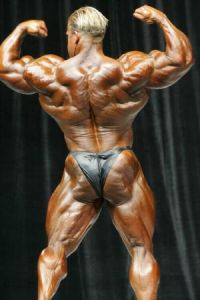 The saying goes, “He who has the best back wins the Sandow,” and the past two years, Cutler had the fullest rear torso on the Olympia stage. The current Mr. O lacked the fine detailing of others, but his immense wingspan in the rear lat spread distinguished him from O challengers in back-to-back comparisons.
The saying goes, “He who has the best back wins the Sandow,” and the past two years, Cutler had the fullest rear torso on the Olympia stage. The current Mr. O lacked the fine detailing of others, but his immense wingspan in the rear lat spread distinguished him from O challengers in back-to-back comparisons.
Back to Basics
“After I went back to the basic barbell and dumbbell exercises in 2005, I got my back to that Mr. Olympia level. I was always wide, but movements like barbell rows, one-arm dumbbell rows, deadlifts and T-bar rows really brought out the thickness in the lats and the middle back. You just can’t get away from the free-weight basics if you want to maximize back size.”
5 Franco Columbu
Width frequently corresponds to height, but at 5’5″, Columbu was broader than even bodybuilders who towered over him, and at his peak he likely never lost a back pose. In addition to his wideness, his lats, traps and spinal erectors were remarkably dense, due in part to his powerlifting background. Weighing around 200 pounds, the Sardinian strongman reportedly deadlifted more than 700.
Variety Show
“The best way to strengthen the lower back is to use a variety of heavy bending-over exercises. Right at the top of the list is the deadlift. Repetition cleans are another excellent exercise when done with a heavy barbell. Heavy bent-over rowing is primarily an upper back exercise, but it is also very beneficial for the lower back. The best advice that I can give you is to work your entire back–both upper and lower–with a variety of movements.”
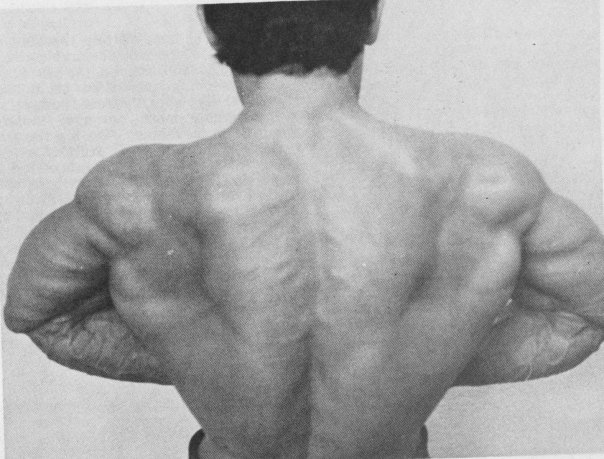 4 Lee Haney
4 Lee Haney
 Haney’s physique of the late ’80s marked a transition from the “lightweight era” of 1976-83 and the supersizing of the ’90s. Nowhere was this more evident than in his best bodypart, his back, with its distinctly modern medley of width, density and definition. The eight-time Mr. Olympia’s low lats swelled out so far they overwhelmed challengers in even the front double biceps and front lat spread.
Haney’s physique of the late ’80s marked a transition from the “lightweight era” of 1976-83 and the supersizing of the ’90s. Nowhere was this more evident than in his best bodypart, his back, with its distinctly modern medley of width, density and definition. The eight-time Mr. Olympia’s low lats swelled out so far they overwhelmed challengers in even the front double biceps and front lat spread.
3 Joel Stubbs
When, after his pro debut, we put a then-unknown airline pilot on our December 2005 cover with the provocative question “Best Back Ever?” many balked at the alleged heresy of even asking. The bodybuilding community has now caught on to what we first saw. Stubbs doesn’t possess the thickness in his rear double-biceps shot that the two men ranked above him had in their prime. However, the 6’3″ Walking Wall has bodybuilding’s all-time broadest back and perhaps its most phenomenal pose when he unfurls (and unfurls and unfurls) his rear lat spread. Best back ever? It’s open to debate.
Multiple Chins
“I like doing chins first and with different grips, because this really warms up the various back muscles and stretches them out. When I change my hand positions, I feel different muscles working in different ways. I feel more of my upper lats and rear delts working with the wide forward [overhand] grip. With the hammer [palms facing each other] grip, I feel more of the traps tying into the rhomboid area. With the reverse [underhand] grip, I feel more of my rhomboids and the lower part of my lats.”
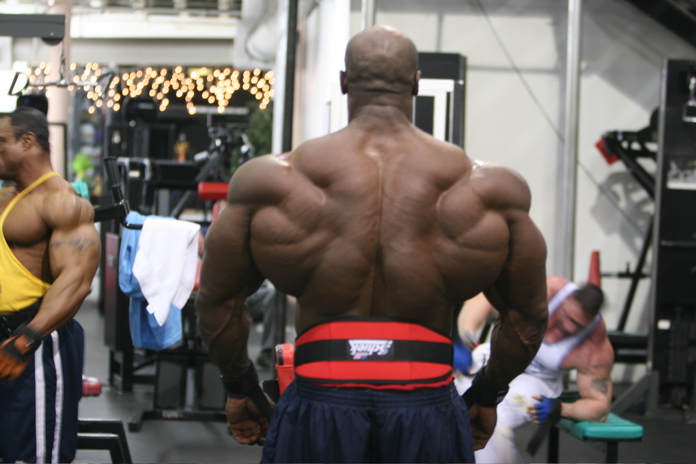
2 Dorian Yates
The supersizing that Haney preceded was best personified in the man who followed him as Mr. Olympia. The Shadow’s lats hung low and stretched wide as if to form a perfect (huge) square, and their inner, lower drape framed a prominent lumbar Christmas tree, but the quality that most distinguished his back was its unparalleled thickness. He sported football-sized slabs of inner traps, spinal erectors that resembled Doric columns and lats so dense their depth was a winning advantage even in front shots. All were visual manifestations of Yates’ high-intensity workouts.
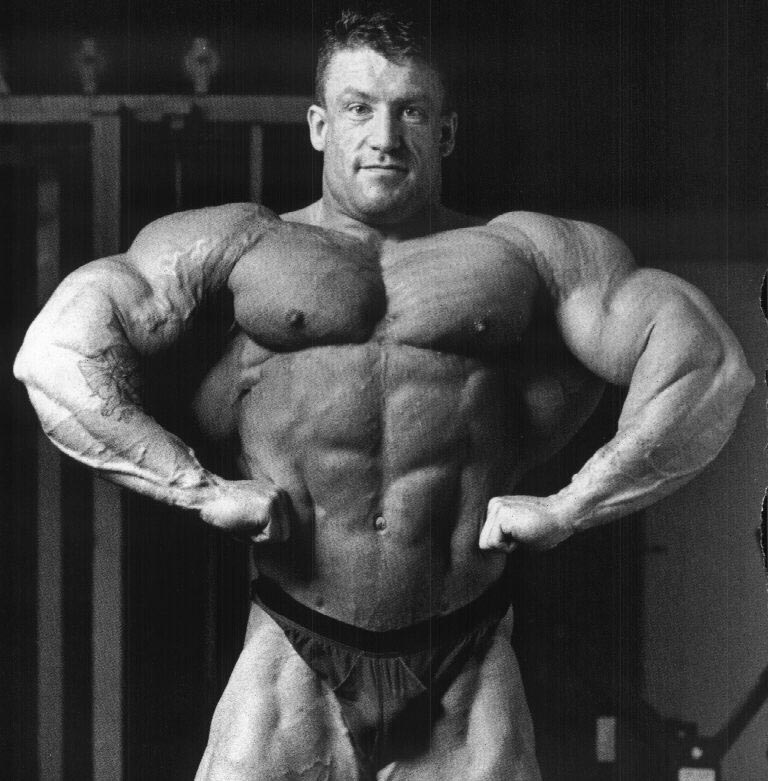
Best Of Dorian Yates
1 Ronnie Coleman
For much of the ’90s, there was little dispute that Yates had the best back ever, and there are many who contend so today. Now, there is a debate, for during the first years of his Olympia reign, Coleman also displayed low-lying, ultrawide lats, but whereas Yates had more grainy ruggedness, Coleman had more feathered refinements. The moments just before he hit his rear lat spread and rear double biceps were contest highlights, as ridges and knots roamed and stripes and crevices emerged, morphing his back into a new and spectacular landscape each time he moved his arms. At his best, his back was like a great symphony orchestra, big and booming, sometimes overwhelming, and yet each finely tuned part played its role precisely.
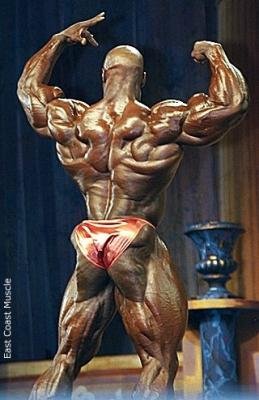
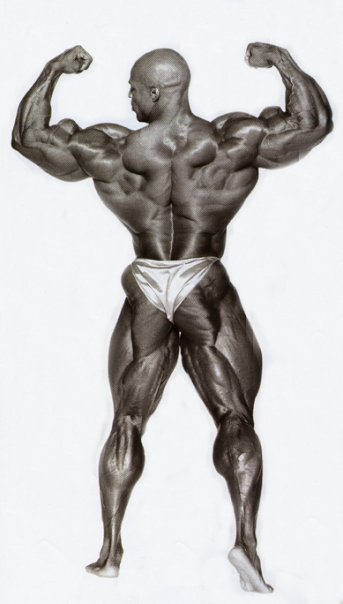
Ronnie Training Back
Author: Greg Merrit, Senior Writer Of Flex Magazine
References:
- COPYRIGHT 2008 Weider Publications
- COPYRIGHT 2008 Gale, Cengage Learning
- http://findarticles.com/
